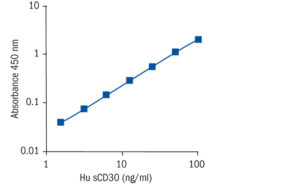sCD30 Human ELISA
The CD30 (Ki-1) molecule was identified by a monoclonal antibody which was originally found to react with an epitop present in Hodgkin’s and Reed-Sternberg cells in Hodgkin’s disease. Later, the Ki-1 antigen was found to be consistently expressed by a subgroup of diffuse largecell lymphomas that were called Ki-1 positive (Ki-1+) anaplastic large-cell lymphomas (ALCL). Characterization of the CD30 antigen has shown it to be in its mature form a transmembrane protein of about 120 kDa elaborated from an 84 kDa cytoplasmic precursor primarily through glycosylation. The cloning of the CD30 gene has allowed the identification of a cDNA with an open reading frame predicting a 595 amino acid polypeptide. The extracellular domain of CD30, comprising 365 residues, has proved to be homologous to that of the TNF-receptor superfamily. The CD30 gene is localized at chromosome 1q36, closely linked to other members of the TNF receptor superfamily comprising TNF-receptors, nerve growth factor, CD40, APO-1/Fas, CD27, OX40 and the neurotrophin receptor. The CD30 ligand (CD30L) has been identified, showing significant homology to TNFa, TNFb, FasL, CD40L, CD27L and
4-1BBl. CD30L is expressed on activated T-cells. Interactions of the cytokine receptor CD30 with its ligand induces pleiotropic biologic effects, such as differentiation, activation, proliferation and cell death. In CD30+ ALCL cell lines binding of CD30L induces apoptotic cell death. CD30 furthermore seems to be involved in the control of the CD40/CD40L signal, T-cell proliferation and B-cell maturation induced by T-cell cytokines. Thus, CD30 seems to transmit information that is essential for the immune response.
CD30 expression is strictly dependent on activation and proliferation of T- and B-cells. In pathological conditions, CD30 positivity is regarded as a peculiar attribute of Hodgkin’s and Reed-Sternberg cells.
There is growing evidence for a potential role of the CD30 molecule in clinical use and therapy. An 85 kDa soluble form of the CD30 molecule (sCD30) has been shown to be released by CD30+ cell in vitro and in vivo.
It is probably derived from the 120 kDa membrane bound molecule by proteolytic cleavage. Serum sCD30 detection can be regarded as a marker of the amount of CD30+ cells present in the body.
Research topic
Cell surface proteins (sCD), Oncology
Type
Sandwich ELISA, HRP-labelled antibody
Applications
Serum, Cell culture supernatant, Plasma (EDTA, citrate, heparin)
Sample Requirements
25 µl/well
Storage/Expiration
Store the complete kit at 2–8°C. Under these conditions, the kit is stable until the expiration date (see label on the box).
Calibration Curve

Calibration Range
1.6–100 ng/ml
Limit of Detection
0.3 ng/ml
Intra-assay (Within-Run)
CV = 4.1%
Inter-assay (Run-to-Run)
CV = 5.6%
Spiking Recovery
104,00%
Dilutation Linearity
99,00%
– Ishikawa C, Jomori T, Tanaka J, Senba M, Mori N. Peridinin, a carotenoid, inhibits proliferation and survival of HTLV-1-infected T-cell lines. Int J Oncol. 2016 Aug 4; – Ishikawa C, Senba M, Mori N. Efficiency of AUY922 in mice with adult T-cell leukemia/lymphoma. ONCOLOGY LETTERS. Wednesday, May 25, 2016;

